February 29, 2024 – Volume 26, Issue 2
In This Issue
- Flanigan’s Net Positive: Solar is Surging
- California Hits the 100% Renewable Mark
- BMW’s Hydrogen Series
- Taos’s Electric Snow Cat
- Super Green Super Bowl
- Floating Offshore Wind Updates
- Offshore Wind and the Jones Act
- Seagliders
- Lunching and Learning: The Power of the Increment
- Flanigan’s Eco-Logic Podcast Updates
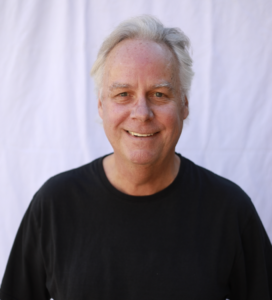
Flanigan’s Net Positive: Solar is Surging
Utility-scale solar is surging! This past year was a record year, solar was 49.3% of all U.S. capacity additions in 2023. Solar now constitutes 7.9% of the nation’s total available generating capacity, tying hydropower. Combined with wind, biomass, and geothermal resources, renewables are now 29% of total U.S. utility generating capacity.
Solar is rising, and fast. Solar’s capacity is expected to exceed wind and coal in the next three years.
The U.S. Energy Information Administration reports that 18.4 GW of solar was installed in 2023, double the prior year. That is expected to double again in 2024. Texas will add the most solar, followed by California and Florida.
Developers are expected to add at least 36.4 GW of solar in 2024. EIA anticipates 470 new solar projects and 220 energy storage installations. There is 14.3 GW of battery capacity anticipated for 2024. Solar power paired with battery storage is expected to account for 81% of all new capacity installed in 2024. Projects such as Gemini in Nevada will feature 690 MW of solar, combined with a 380 MW/ 1.4 GWh battery installation.
Even bigger is an installation in California: The Edwards and Sanborn Solar and Energy Storage Facility is now operational in Kern County. It generates 875 MW of DC power and can store 3.9 GWh of energy storage. Its total interconnection capacity is 1,300 MW, earning it the distinction – at least for now – as the world’s largest solar + storage facility. The project was developed as a public-private partnership with the Air Force. It is built on a mixture of private land and land owned by Edwards Air Force Base, specifically an unused portion of the base, a parcel of land on the northwest corner of the base. Developer Terra-Gen and the Base signed an Air Force Enhanced Use Lease (EUL) for 35 years. Through the EUL program the Air Force can lease underused land to private-sector developers.
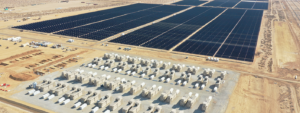
Image Courtesy of Mortenson
The 4,660-acre project began in 2021 with substantial completion reported last year. It is made up of more than 1.9 million First Solar photovoltaic panels and 120,720 LG Chem, Samsung, and BYD batteries. The Edwards and Sanborn solar + storage site supplies power to the City of San Jose, Southern California Edison, Clean Power Alliance, Pacific Gas and Electric, Starbucks, and others.
We’ve come a long way Don Osborn! Now retired, Don was Sacramento Municipal Utility District’s first solar program manager and a visionary and advocate extraordinaire. He dreamt of a time when there would be at least 60 MW of solar production worldwide! Then the market would mature, he postulated.
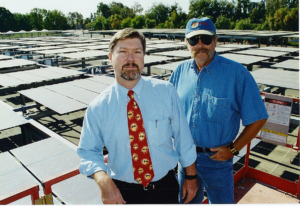
Today, and in California alone, there are 36,400 MW of solar projects anticipated this year. Nationwide, the Federal Energy Regulatory Commission (FERC) reports a high probability of 87,098 MW of additional solar installed from 2024 – 2026. Others believe ~200,000 MW may be more likely in the three-year period. Solar is surging; solar is becoming dominant.
All this utility-scale action is remarkable. But concurrently, rooftop solar – distributed energy resources, or just DG – is under utility siege. A new form of net energy metering – called net billing – adopted by the California Public Utilities Commission, has far less beneficial values for homes, schools, and businesses. As a result, in California, rooftop solar sales are down 77 – 85% and nearly 17,000 jobs have been lost so far. Clearly big solar is providing great value, while distributed solar is being devalued despite its inherent local economic development and resilience benefits. We need both forms of solar. Fortunately, California legislators are introducing bills to redirect the Public Utilities Commission’s ruling.
Quote of the Month
“Hydrogen is a versatile energy source that has a key role to play in the energy transition process…. Hydrogen is the missing piece in the jigsaw when it comes to emissions free mobility.”
California Hits the 100% Renewable Mark

Image Courtesy of California Energy Commission
SB 100 legislates that utilities in the State of California must be powered with carbon-free electricity by 2045, 50% by 2025. These are big, bold initiatives. Remarkably, the State’s utilities are on track with the 2025 goal. And the 100% target is coming into sight too.
The target is coming into sight with proof of concept: Several times now the entire State of California has been powered by renewable energy. This has been achieved in Germany and Spain, and even Texas was 70% renewably powered one Sunday this month, 83% carbon-free when factoring in nuclear.
In California, the first time was May 8, 2022 when renewables provided 103% of consumer demand. This year the California Independent System Operator (CAISO) has reported that it has hit the 100% mark reached several times. On Sunday, February 18th, at 11:10 in the morning, and for the third time in nine days, renewables powered the entire grid. On that day, the CAISO reported that renewables generated 108% of consumption, fulfilled by wind (8.96%), geothermal (5.28%), small hydro (1.71%), big hydro (5.92%), and solar (86.25%).
At these times, fossil fuels are not totally eliminated. As the sun goes down, solar capacity has to be replaced quickly with hydro and natural gas plants. Many of the large gas plants aren’t designed to be turned on quickly, they take 4 – 8 hours to ramp up. Thus, some of them must be left on to respond to and meet the sun-down demand. The result is that on some days, excess renewable power is exported out of state, and in worse cases, solar farms are turned off because there’s simply too much power on the grid. To address the excess, batteries are being deployed. Good news: Energy storage has grown 20-fold in the past two and half years in California.
BMW’s Hydrogen Series
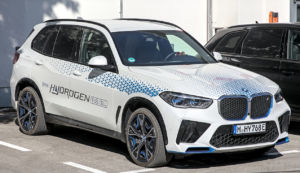
While automakers around the world are going battery electric, the BMW Group considers itself to be “an absolute pioneer” in the hydrogen fuel cell EV space. It is supporting innovations and policies to shore up hydrogen technology, particularly green hydrogen.
After four years in development, BMW has launched the BMW iX5 hydrogen pilot fleet. The new iX5 vehicles are now out on the road. The pilot fleet, deployed worldwide, will be used for trial and demonstration purposes. The iX5’s hydrogen fuel cell system was developed by BMW at its Munich Research and Innovation Centre.
Backing up a bit, electric vehicles come in different forms: Battery electric vehicles (BEVs) use batteries to store and discharge power to electric motors that propel the car. Fuel cell electric vehicles (FCEVs) have a tank of hydrogen on board. The hydrogen is then run through a fuel cell to generate electricity on board to power electric motors that propel the car. Each BMW iX5 has two fuel tanks that each hold three (3) kilograms of hydrogen. This gives the car a range of 504 miles; refueling takes only 3 – 4 minutes.
FCEVs, like all cars, have an auxiliary battery to power non-traction accessories. To make things complex, a hydrogen FCEV, like a battery EV, also has a traction battery on board for two reasons, it’s just a lot smaller than a BEV battery. First, the fuel cell generator feeds power to the high-performance lithium-ion battery, which is highly responsive and can deliver up to 295 kW and 401 horsepower. The battery smooths out the power delivered from the fuel cell with the option to turn off or idle the fuel cell during lower power needs. Second, FCEVs use the battery for recapturing braking energy, providing extra power during short acceleration events.
Munich, Germany is BMW’s home town. At its famous Bavarian plant there, it has produced motorcycles and later cars since 1922. Marking a fundamental shift, BMW will cease production of internal combustion engine (ICE) vehicles at the end of 2026. The plant will have manufactured ICE vehicles for 75 years. Thanks to a 650 million Euro investment, the plant will be entirely shifted over to production of EVs.
Taos’s Electric Snow Cat

Taos Valley Ski Resort is a B Certified ski resort located in New Mexico. It has a net zero target of 2030. It has already deployed electric snowmobiles, utility terrain vehicles, and snowblowers. Taos now boasts that it is the first ski area in America with a fully-electric “snow cat,” snow groomers that pack snow and create idyllic skiing, snowboarding, and snowmobile trail conditions.
The Prinoth Group is an Italian company that specializes in producing heavy equipment for challenging conditions… things like moving earth, grooming snow, and managing vegetation. It launched its first all-electric “snow groomer” in 2022, the Husky eMotion. The Prinoth snow cats have a number of benefits: They are more powerful than diesel models with an instant torque of 1,000 Newton Meters (a unit of torque also known as moment.) The Cats have a 180 kW (245 hp) battery with a storage capacity of 100 or 200 kWh, the latter providing power for three hours. They are quieter and cut carbon emissions by 1,100 pounds per shift.
The first Husky eMotion was purchased by the City of Oslo, Norway where all city-owned vehicles and machines must be emissions free by 2025. The Husky eMOTION was put in service at Holmenkollen, preparing World Cup trails. The next Husky slated for America will be heading to the Sleepy Hollow Inn Ski and Bike Center in Huntington, Vermont.
Speaking of ski areas, the United States has lost 23% of its snowpack since 1955. Thus ski areas are relying on supplemental, artificial snow-making systems that pipe water uphill and then use energy-intensive compressors to power snow guns. Gains have been made making this equipment more efficient, and less at odds with climate protection. An initiative managed by Efficiency Vermont some years ago – the Great Snow Gun Roundup – replaced 10,000 outdated models, the new models using 80% less energy.
Super Green Super Bowl

This year’s Super Bowl – LVIII was remarkable. It was the most watched event in U.S. television history. According to Nielsen ratings, the game drew 123.7 million viewers and fully 202.4 million viewers watched at least part of the game. It was also the longest Super Bowl in history, being one of only two of the 58 Super Bowls to go into overtime. It was also remarkable in that it was powered with green and clean energy with no greenhouse gasses.
Some called it an environmental milestone, powered entirely by renewable energy. The home town football team and stadium’s anchor tenant, the Las Vegas Raiders, has entered into a 25-year agreement to power the stadium with a solar field owned by NV Energy located in the nearby desert. NV Energy CEO, Doug Cannon, noted that the solar farm would deliver more than 10 MW for the game. And the show must go on! Half time is critical. Before the game Cannon assured everyone that, “We have enough power for Usher and all his lights and all the fanfare that’ll be there.”
@cbsnews It takes a lot of energy to power #SBLVIII and Usher’s highly-anticipated halftime show. And this year, that power is coming 100% from renewable energy. ☀️ Here’s how the home of the @Las Vegas Raiders is using solar power to prepare for the biggest game of the season – and how the Department of Energy Sec. Jennifer Granholm says it showcases a “huge piece of how we’re going to get to 100% clean electricity.” #superbowl #cleanenergy #solarpower
The Raiders – led by President Sandra Douglass Morgan – are proud of their steps with sustainability. Allegiant Stadium is LEED Gold. Its roof is made of a sustainable plastic material called ETFE that allows 10% of the daylight, without the heat, and thus cutting air conditioning costs. Energy optimization at the stadium is rooted in a state of the art chiller plant. The stadium’s grass field is moved outdoors on a rail system to reap natural sunlight rather than using energy-intensive grow lights.
Allegiant Stadium is committed to developing sustainable policies and constantly improving on these efforts through waste diversion of 20 materials streams. Grass clippings and food waste are composted. It donates 12,000 pounds of food scraps per game to a local livestock farm for feed. Water saving is equally sophisticated… with water-saving fixtures cutting water use by hundreds of millions of gallons per stadium event. Wastewater nourishes the landscaping around the stadium using a subsurface dewatering system.
The Raider are also connecting with local community eco-efforts, actively engaging team members and guests in sustainable practices. There is a big focus on education on the game day. It’s an impressive effort.
Floating Offshore Wind Updates

In September of 2022, the Biden administration built on its own goal of 30 GW of offshore wind by 2030, calling for 15 GW of floating wind turbines by 2035. While conventional offshore wind turbines can be secured directly to the sea floor in shallow waters, deep water areas require floating turbines.
Globally, far less than a gigawatt of floaters had been deployed, compared to 50 GW of fixed-bottom offshore wind. President Biden’s Energy Earthshot program – modeled after the famous Moonshot initiative in the 1960s – includes The Floating Offshore Wind Shot aims at reducing costs by more than 70% by 2025, cutting production costs to $45 per MWh.
Floating wind turbines are now no longer a dream or future expectation. One wind farm off the coast of Portugal has been in operation for three years. At Ion Viana do Castelo, three 8.4 MW wind turbines are chained to the sea floor, then connected with 12.4 mile long cables that deliver wind power to the onshore substation.
The world’s largest floating wind farm is off Scotland. The Kincardine wind farm is nine miles off the coast of Aberdeen, and is 50 MW in size, made up of 2 MW and 9.5 MW turbines.
A recent announcement eclipses Kincardine in a big way: Engineering News Record reports that front-end engineering has begun on a 1,000 MW (1 GW) floating wind farm off Uslan, South Korea. The Hanwoori project will use the three-legged WindFloat platform developed by California-based Principle Power.
Back stateside, the U.S. Bureau of Ocean Energy Management (BOEM) has finalized two offshore Wind Energy Areas off Oregon’s coast. Together, the area totals 195,012 acres with a 2.4 GW potential. The Coos Bay area is located 32 miles off shore. The Brookings area is close to the California border and is 18 miles offshore. Oregon has a stated goal of 3 GW of offshore wind by 2030. Given the sheer drop off, the turbines there will be floaters.
BOEM claims to have worked to avoid 98% of the areas recommended for exclusion due to their importance as commercial fishing grounds. There is, however, continued opposition to the proposed wind farms from groups including the Confederated Tribes of the Coos, Lower Umpqua and Siuslaw Indians. Furthermore, the head of the Midwater Trawlers Cooperative stated that, “authentic engagement with BOEM has been nonexistent,” and that, “BOEM will stop at nothing until our oceans are littered with wind turbines….” The next step is for BOEM to prepare an environmental impact assessment of these areas.
Offshore Wind and the Jones Act
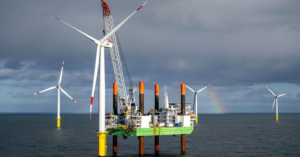
Canary Media presented an insightful piece this past week on how a little-known, obscure federal law known as the Jones Act is holding back the deployment of U.S. offshore wind. The Jones Act, more specifically Section 27 of the Merchant Marine Act of 1902, is impeding the installation of offshore wind turbines in America. It requires the maritime transport of goods from one point in the U.S. to another to be done using an American ship. The federal law requires that U.S. vessels move the goods.
The problem is that the Jones Act applies to offshore wind, and moving parts from a port to an offshore wind farm requires American ships. But the U.S. lacks the right kind of vessels. In their stead, barges are being used that are highly inefficient in the turbine installation process. This is causing delays and time-related costs and has played a part in project cancellations.
Canary reports that what the U.S. wind industry needs are Wind Turbine Installation Vessels (WTIVs), purpose-built vessels, transportation and construction rigs in one. WTIVs are special ships that are designed to carry turbine parts to their new sea homes. They have a big crane, deployable legs, and dynamic positioning. They are common in Europe and other parts of the world. They are major ships, with a major price of $625 million each. They can carry a crew of 119. The ships have onboard cabins, mess rooms, as well as cinemas, gyms, and hospitals.
To be Jones Act-compliant, the ships must be built in the United States… not at ship-building facilities in Europe or South Korea. They must also be owned and crewed by Americans. There is one being built in Texas that will be fully compliant, but experts claim that 5 – 6 WTIVs are needed to support the U.S. offshore wind industry.
Seagliders
Seagliders are a new form of transportation designed by two MIT aerospace engineers and envisioned for island-to-island transportation. Instead of flying 13,000 feet above the water like a small commuter plane, Seagliders will fly just a wingspan above the water’s surface. Planned for short hops between islands, seagliders are boats that rise up to 30 feet above the waves. Instead of flying high, the seaglider operates like a hovercraft using the ground effect, the cushion of air beneath with wings. Like a plane… like a flying boat!
The Regent Seaglider is an all-electric, eight engine aircraft that will take off and land on water the same way a seaplane does, but flies at 180 miles per hour just above the water’s surface. Imagine a quick trip to the Hamptons, or the Vineyard. It attains high speeds on a cushion of air. They are anticipated to have half the operating costs of conventional aircraft, with much less noise and emissions. With a range of 180 miles, they may serve well as very fast commuter aircraft between urban centers and coastal areas, at least six times as fast as a conventional ferry. The Seagliders are being funded by the Founder Fund, a group of investors including Mark Cuban, owner of the Dallas Mavericks.
Lunching and Learning: The Power of the Increment

A few days ago, I was pleased to be the motivational lunch and learn speaker for an organization that is focused on climate change and its employees’ actions to promote sustainability. It was for the State of California State Compensation Insurance Fund and was a half-hour long followed by a wide range of questions.
The virtual lunch and learn focused on sustainability, its seven spheres, and the massive carbon threat to sustainability. Then the focus was on our individual carbon footprints, and then how to cut carbon in our lives, in both really simple and big ways… from installing LEDs, carpooling, buying locally, to reducing packaging.. The presentation was peppered with actions that each of us can take daily to “save a ton” of carbon.
The talk ended with a vision of the future of a higher quality of life, with new integrations… like smart cars integrated as appliances, supporting not only our own carbon reductions but also providing community benefit through vehicle to grid integration. V2G is a win-win advance, and a harbinger of synergies that will actually enhance the quality of our lives while mitigating environmental damages.
Flanigan’s Ego-Logic Podcast Updates
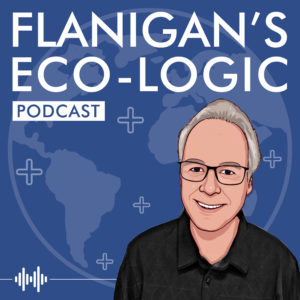
Use the links below to check out our recent podcasts. And you can always go to Spotify and type in “Ted Flanigan” to find our library of podcasts.
Recently Released:
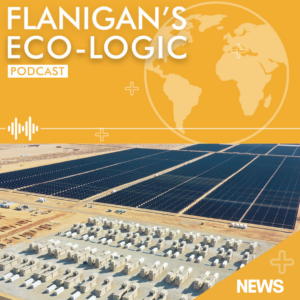
EcoNet News, Volume 26, Issue #2, highlights the surge in utility-scale solar across the US. Ted shares California’s progress towards its 100% clean energy target, with the State’s utilities on track with the 2025 goal. Ted goes on to highlight BMW’s hydrogen pilot fleet, Taos’s electric snow cat, the Super Bowl’s environmental milestone – powered entirely by renewable energy, floating offshore wind updates and the Jones Act, and all-electric seagliders.
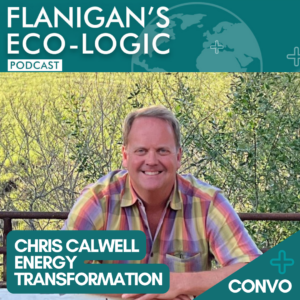
In this episode of Flanigan’s Eco-Logic, Ted speaks with Chris Calwell, Adjunct Professor of a graduate course on International Renewable Energy at the Middlebury Institute of International Studies in Monterey, CA. He is also a Principal at Ecos Research, focusing on clean energy technologies and their transformation in our society. His other passion, outside of Ecos Research, is proactively investing in cleantech and tracking down the companies that are doing the best job of preventing climate change, as opposed to running down a checklist of bad things companies aren’t doing if you want to buy their stock.
Chris is an internationally recognized expert operating at the intersection of the technologies and policies needed to address climate change, particularly in the fields of energy storage, electric vehicles, and renewable energy. Chris served seven years in the NRDC Energy Program, then co-founded Ecos Consulting in 1997, working with a team of researchers on behalf of the U.S. EPA ENERGY STAR® program, the California Energy Commission, PG&E, NRDC, NEEA, NYSERDA and Natural Resources Canada to improve the energy efficiency of residential lighting, appliances, power supplies and consumer electronics through voluntary labeling and incentive programs and mandatory efficiency standards.
He and Ted dig into his works in consumer electronics and the external power supply story. They discuss Eco’s startling revelations about the standard test for television efficiency at the time, as well as cleantech investment. He shares that he continues to do consulting work in the Energy Star world, and is currently in discussions with them on some additional work related to batteries and EVs.
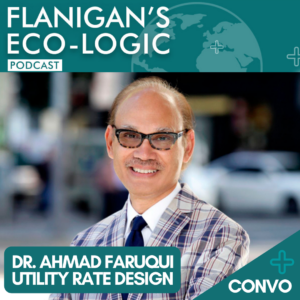
In this episode of Flanigan’s Eco-Logic, Ted speaks with Ahmad Faruqui, an energy economist whose distinguished career working with electric utilities encompasses expert rate design, demand response program structures, the integration of distributed energy resources into the grid, demand forecasting, decarbonization, electrification and energy efficiency, and load flexibility.
He shares his journey in the energy world, highlighting the Demand and Conservation Program at the Electric Power Research Institute (EPRI), as well as his consulting works at The Brattle Group. He also shares the more contentious parts of the journey, seeing the utility industry go from basic rate structures to more sophisticated rates, leading to the question of what rates do in the ideal that help society, and diving into the net energy metering / net billing issue.
He concludes by sharing the energy efficiency improvements he’s made in his home over the years, including changing HVAC equipment, installing rooftop solar, adding battery for backup during outages, and buying an EV, all leading to bill savings and happiness as a result.

In this episode of Flanigan’s Eco-Logic, father-daughter duo, Ted and Sierra Flanigan host the clean energy crash course mini series focusing on Ted’s international travels, highlighting 40 years of international trips, which gave him a global perspective on energy issues. This led to reporting on these issues and opening people’s eyes to energy innovations and technologies all over the world.
In part 1, Ted begins with the lessons learned from his fulfilling experiences abroad that have enriched his work life. Throughout all his years of international travel, his biggest takeaway is that 98% of the people in the world are good people, and he’s constantly been reassured through human connection and learning from different cultures.
Ted and Sierra reminisce on his works in Canada in the James Bay area and the huge hydro Quebec Electric projects there, as well as his works in Ontario and working for the City of Toronto as it sought soft path solutions. They also cover his time in Moscow at the Global Forum on Sustainable Development in 1988, when he was asked to attend as a sustainability expert to help guide the forum on behalf of Rocky Mountain Institute (RMI).
Ted concludes with a favorite trip, an experience which was also afforded to him via RMI, in Singapore, and thanks to Lee Eng Lock, that culminated with a side trip into the jungles of Malaysia and the South China Sea. Sierra thanks him for taking a trip down memory lane, and reiterates the idea of being open and receptive to what other cultures have to teach us – which is a lot.

In this episode of Flanigan’s Eco-Logic, father-daughter duo, Ted and Sierra Flanigan host the clean energy crash course mini series focusing on Ted’s international travels. They build on the first episode of the three-part series, which focused on Ted’s travels in the 80s. In part 2, they focus on the 90s.
Ted begins with his work with the International Council for Local Environmental Initiatives (ICLEI) and his involvement in the Urban Carbon Reduction Project. The idea was for local environmental movements to take form, which was then taken internationally. Ted shares stories from Ankara, Turkey, Helsinki, Finland, and Omiya, Japan.
They then move on to The Results Center, discussing the genesis and players involved, the importance of the era, and the legacy of it. The idea was to write case studies of the most successful programs and approaches, starting with North America, and then looking broadly and out of the country. Ted and his team wrote 128 case studies, including a series of case studies on Europe.
Sierra and Ted conclude with the linking of ideas around climate action to a universal way of connecting and growing relationships and strengthening bonds, underscoring the value of meeting people where they are, creating greater visibility around the numbers, opening channels of communication, and cross-cultural collaborations that Ted facilitated and shed light on.
